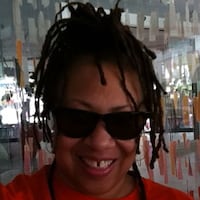When Onaje Henderson bought a house at age 23, the first item the young engineer bought was a painting by Patricia Bohannon.
He had acquired the abstract painting from an exhibit featuring the work of African American artists.
His friends couldn’t understand why he spent money on artwork instead of other household items.
“I realized at the time that the reason my circle was not collecting was not because we couldn’t afford it, but because no one ever talked to us about collecting and the importance of it for both personal and cultural reasons,” he said.
Henderson and his partners, his brother Omari and Troy Taylor, hope to expose more Black consumers to the world of art collecting. The three friends, who are all engineers, are co-owners of the ZuCot Gallery at 100 Centennial Olympic Park Drive SW.
The gallery, which specializes in Black art from around the diaspora, was started by Taylor in 2008. The Henderson brothers owned a separate art business called Premier Art, an artist management and art education company, which started in 1993.
They formed the company while in college at Tuskegee University to help manage the career of their engineer-artist dad Aaron F. Henderson. Premier Art morphed over time to the brothers working with other artists.
Taylor, who was working for a Fortune 500 company at the time, bought space in the Castleberry Hill community. Taylor was already an avid collector and had amassed several works from his travels around the world.
The three met at an art tasting and started talking about art and their work. They hit on the idea of working together and it grew from there.
The pivotal moment came in 2011 when Taylor joined forces with the Hendersons, who quickly dubbed themselves “The Art Brothers.”
The gallery’s name is a nod to Taylor’s paternal grandmother, Frances Ann Taylor, who was born in the late 1800s on St. Kitts. His grandmother was a trailblazer and one of the first women to run a stall in the produce market. To succeed, he said, she had to develop a tough skin, and people on the island used to say she was “tough as a zoo cat.”
Her nicknamed was tweaked to ZuCot.
The ZuCot owners hope even a pandemic — which has forced the gallery to open by appointment only — won’t stop people from buying art. In fact, they hope it will help the business.
With so many people working from home, perhaps they are “spending more time looking at their walls and thinking what can be done to make them look better,” said Omari Henderson.
The 2012 National Endowment for the Arts, Survey of Public Participation in the Arts, showed that 41% of college-educated adults visit art museums or galleries. They’re not the only ones attending, though the rate for adults with less education visiting them is just under 13%
“Art is more than just a pretty picture,” said Taylor. “It’s a moment that encapsulated events in history. It will outlast all of us.” He points to early cave drawings, which, he said, were used as a way to communicate what early man did, what they hunted and how they lived.
They want to make everyone feel comfortable in their gallery.
When they used to visit different galleries around town, said Onaje Henderson, they did not always feel welcomed. They felt ignored. No one spoke to them or even acknowledged their presence.
“They didn’t take us seriously,” said Omari Henderson. “We were young, Black and collecting art. They knew that we were in the art business and they were not taking us seriously, that they would not take the average person seriously.”
He said there is an enormous talent pool of Black artists in metro Atlanta; “they just don’t have enough outlets to show their work. There’s not enough galleries that will show the work of African American artists. There aren’t enough dealers to get their work to people and just not enough education.”
And not enough museum curators who take African American art “seriously and view African-American art as American art,” adds Taylor.
They’ve worked with artists Charly Palmer, E. Richard Clark, Tracy Murrell and Aaron F. Henderson, the Hendersons’ father, who recently published a book, “Fight On: A Visual Interpretation of African American Spirituals.”
The book, which is available through ZuCot, expresses the story of the African American spirituals tradition through 59 paintings from a series by the elder Henderson, 56 religious songs’ lyrics and narratives by the author and art and culture scholars.
Prices for the works at ZuCot Gallery typically range from $1,500 up to $50,000.
Clients have included corporations, celebrities and museums.
Part of their mission, said Omari Henderson, is to break down the intimidation factor when it comes to buying and collecting artwork. They have had people discuss the process of creating a piece and understanding how to value an item.
Art is something that can be passed down from generation to generation.
You don’t have to be a Diddy, who, in 2018, plucked down $21 million for a work by African American artist Kerry James Marshall, according to Black Enterprise.
Or a Tina Knowles Lawson, an African American businesswoman and mother of Beyoncé and Solange, who shared her love for art in a Vanity Fair piece in 2018.
Taylor said art collectors are considered “custodians of culture,” and the gallery owners hope to reach out to younger collectors. They have held tours for public school students and art tastings to talk about the business of collecting fine art.
“It tells a story of who we are as a people, our narratives and our journeys,” said Taylor.
About the Author
Keep Reading
The Latest
Featured


